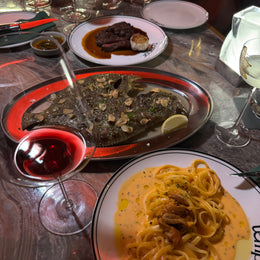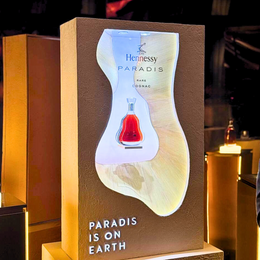
Fernet Branca is that one drink that either raises eyebrows of doubt or gleeful expressions of fanaticism. The divisive bitter liqueur has equal amounts haters and lovers. What's the craze all about? Here's the deepdive on this bitter, herbal liqueur.
I’ve had the chance to go to the Fernet Branca Museum (Museo Branca), situated just at the outskirts of Milan. The tour guide for the day was Roberta Pala, the International Marketing Coordinator of the Fernet Branca team.


Today’s tour group was a mix of nationalities – us, a bartender hailing from the US, and a family of Argentinians.

The Fernet Branca crest, on top of the archway.
To enter the Fernet Branca museum, you have to turn into a small door. There, you sign in with the security officer, and proceed to wait at the holding room. The holding room is adorned with Fernet Branca’s most classic poster’s – more on that later.

Nothing says international branding more than multiple languages flanking your logo.
When the tour group was ready, we were shown into the first display – a painting of the Fernet Branca building, with the portraits of the Branca family on top. Roberta notes that the painter made a mistake – the two apexes of the Fernet Branca building in the painting had seven windows – when in reality, there’s only six.

I went to check after the tour, and yes, I can confirm the painter had indeed made an oopsie.
Roberta went on to explain some of the flagship products from the Fernet Branca line. There is the OG Italian bitter, and beside it was the Fernet Branca Menta. The group Fratelli Branca also owns produces a whole range of products, including brandy, grappa (distilled grape spirit), and Punt e Mes – a half-half of vermouth and bitter.

Within the Fernet Branca portfolio includes acquired brands, such as vermouths and other spirits.
A Community Contributed Museum
For a brand that is close to 200 years old, it was relatively forward in terms of advertising. If merchandise is the name of the game now, Fernet Branca understood it way before. Ash trays, mugs, posters, little trinkets – you name it, Fernet Branca probably had made it at some point. And at some point, it’ll be hard to keep track of all the merch you’ve produced over the years.

This was one of the many shelves housing Fernet Branca memorabilia.
Here’s where the community has contributed to the museum. For a bitter so close to the Italian way of life, the museum regularly receives donations and long forgotten memorabilia from folks all over the country. Talk about a customer loyalty program!
Alongside the many merchandises that is displayed, the museum also showcases old tools of the trade. Here’s a few that I took pictures of:
An old still,

A bottle corking machine,

An export crate with the old Fernet Branca logo.

One of Fernet Branca’s more famous collectibles is the coins. Roberta explained that Fernet Branca regularly produces limited edition coins – commemorating important milestones, attending events and such.

Some of the coins are designed around a unique feature of the country it’s representing – like this Oregon coin that jabs at the perpetually rainy weather.

But perhaps the coolest piece of memorabilia is this really vintage advertisement car with the Fernet logo. You know it’s old when the car is built with a left-side drive. For context, Italy and much of Europe switched over to a right-side drive in the 1950s.

Medicine, Not Alcohol
Like many other liqueur brands of the old, many amaros and herbal liqueurs were first conceived and marketed as medicines. To be fair, much of their botanicals have medicinal properties.
All 27 botanicals used in the Fernet Branca have well known medicinal properties – like chamomile, gentian roots, Chinese rhubarb to name a few. The botanicals are all displayed on this wheel, sitting on top of a barrel. Lots of these botanicals are sourced around the world, which is stated on copper plates on top of the wheel.

Pardon the slightly warped perspective - I wasn't quite tall enough to capture the entire wheel in its entirety.
While Fernet Branca looks distinctively dark brown in the green bottle (often used for medicines back in the day too), Fernet Branca has a tinge of iodine-yellow to it that is more perceptible in a cocktail or in a shot glass, due to the saffron infused in the brew. For the most expensive spice by weight in the world, it’s displayed prominently at the centre of the wheel.

A vial of saffron crowning the wheel.
Folks who have had Fernet Branca may have noticed that there’s a mintiness to the bitter. Fernet Branca has another version of their original fernet, the Fernet Branca Menta mentioned earlier. This version of the bitter uses mint harvested from the Piedmont region (the northwest side of Italy), which has limited availability.

This mint is heavily featured in the Fernet Branca Menta as well.
Iconic Posters Make for Good Marketing
Literacy has been taken for granted these days, but back in the day, there was still a sizeable population who couldn’t read. However, imagery was universal - which helped definitely helped in Fernet Branca's fame.
Fernet Branca has, for the longest time, had a reputation for their quirky posters and merchandise. One of the earliest merchandises Fernet Branca sold was the humble calendar - after all, everyone needed a way to track the days of the year. Posters of all sorts with quirky characters made the brand memorable.

Perhaps it’s time to talk a bit about the design of the Fernet Branca logo. We've looked into the Fernet Branca logo here, but here's a quick summary. Fernet Branca aimed to be an international brand – exporting its products all over. Hence, the logo is an eagle carrying a bottle of Fernet across the globe.

A keen observer would have noticed that on the globe, Europe and Italy is featured quite central on the globe, a nod to Fernet Branca’s Milanese origins.

While the eagle is the iconic animal representing Fernet, there’s also the curious case of the happy crocodile. Roberta explains that the crocodile is happy, dancing, while holding a bottle of Fernet Branca – Fernet Branca serves as both an aperitif and digestif. Hence, the crocodile, its belly filled with full, has not much reason to he cranky. The crocodile poster is easily one of my favourites out of the whole museum.

Fernet Branca was so ahead of its time, that it even understood the concept of being hangry before millennial speak.
There’s a whole host of other posters that are more than a century old on display here, but I'll pick some of my favourites. This one shows how Fernet Branca is very international, with the crates of the bitter destined to countries,

And this poster features the Red Cross and a nurse, driving home the medicinal nature of the bitter.

While this may be a bit of a sidetrack, it’s interesting how the museum also has replicas of what the office rooms in Fernet Branca could have looked like back then. A few of the rooms showcase the daily life inside the Fernet Branca building:
A lab where bottles of Fernet Branca undergo quality testing,

And a sewing machine that was used to make Fernet Branca uniforms for the staff.

There isn't really a strict criteria of what could be displayed at the museum - the museum proudly displays multiple thesis written on Fernet Branca, including one of mindful employment.

Last but not least, imitation is the highest form of praise – until people start making counterfeits.

This poster depicts a monkey-see-monkey-do sort of scenario, warning people of Fernet Branca counterfeits.
At the end of the museum, there are display cases of old Fernet Branca products that have been produced, as well as a cabinet full of counterfeits and imitations.

The Cabinet of Shame.
Three Sips and You’re In Love
Before we headed into the basement where much of Fernet Branca production is done, we were invited to a bar space where we were given samples of Fernet Branca.

They say it takes three sips to like Fernet Branca, the first sip is too strong, the second sip introduces the more delicate flavours, and the third sip gets you addicted. Remember how our tour group had a bartender hailing from the United States? They shared that many people like Fernet Branca only on the second try.

Maybe I’m a weirdo, but it didn’t take me three sips or two tries – I liked the bitter on my first sip (this was also my first time having Fernet Branca neat as well).
While much of Fernet Branca meant for the world is made in Milan, Fernet Branca has a second outpost in Argentina. When many Italians were moving to settle in Argentina, Fernet Branca was becoming popular – so much so that they needed to have Fernet Branca production within Argentina itself to supply the local population.
The Argentinian family commented that compared to the stuff made in Argentina, the Milanese stuff tastes a bit stronger and slightly more minty – but otherwise very similar. Interestingly, Roberta has heard a range of opinions, from how the two fernets differed greatly in taste, to them being almost indistinguishable.

Source: Wikipedia. Will get a bottle of Fernet Branca to try this soon.
Here is where I was also acquainted to the Fernandito (a.k.a Fernet con coca) - 7:3 mix of Coca-Cola and Fernet Branca topped with ice, which is said to be the de-facto national drink of Argentina.
What’s in the Basement?
Underneath the museum and bar lies the facilities that make Fernet Branca. The team at Fernet Branca doing production is ten people, the lean team thanks to the degree of automation that goes behind the scenes.
When automation wasn’t as readily available, a worker had to manually stir the herbs in the pot as it undergoes hot infusion – the way the workers discerned if the brew was ready was when the paddle starts to “shine”.

The rim of the pot, where Roberta's elbows are, have been rubbed clean and shiny from years of stirring.
When it came to modernised, large scale maceration and hot/cold infusions of the herbs, we didn’t get to see that. However, what we did see is the many big wooden barrels where Fernet Branca’s products are undergoing maturation. Most of the barrels are double the height of a grown man - the big volumes make perfect logistical sense when you consider that Fernet Branca is aged for one year before being bottled.

Here, in this stainless steel tank room, is where individual botanicals are processed. Roberta mentions how, as a tour guide, she could tell which botanical was being processed for the day just by the ambient aroma permeating throughout the facility. The day’s botanical during our visit was that special Piedmont mint.

Roberta also shared that production staff are often given the moniker “Oompa Loompa” – yes, those tiny factory workers that dart about in Willy Wonka’s chocolate factory. Given the big spacious facility, the production crew sometimes cycle within the building from point to point – like how the Oompa Loompas would travel within the factory (I am not so sure if any of the two movies did show the Oompa Loompas on bicycles though – please let me know if you’re aware!).

The tour ended with us visiting the biggest wooden barrel of the facility – a huge, old barrel that has to constantly be tweaked and plugged with wooden pieces to prevent leaks. In order to prevent the barrel from collapsing under its own weight and pressure, the liquid level of the barrel must be kept constant.

Yep, six windows, not seven.
And that concludes the whole tour! For those who are nerdy about vintage memorabilia and liqueur production, I think you’ll appreciate the Fernet Branca tour (which, by the way, is free of charge!) To book an English tour, check out their website (which you may need to translate in English to navigate).
Here’s a quick guide on how to get to the Fernet Branca museum:
- Get off at Milano Lanchetti station and head upwards.
- *Optional: Stop by Waiting Café and pick up some coffee to-go. Their cappuccino is really good.
- Walk down the street and look for a colourful chimney – there’s where Fernet Branca is.

📍Museo Collezione Branca (Fratelli Branca Distillerie srl)
Via Resegone, 2, 20158 Milano MI, Italy
If you happen to get Roberta as your guide, let them know 88 Bamboo sent you!

@vernoncelli







